“Okay, the tundra trip is on for tomorrow,” said Max, “with the usual ifs and provisos. But we can’t take everyone in the three boats. The students who were not here last year have tickets. Becky has a ticket. Dallas has a ticket. But remember what happened last year.” And he told the story:
The group of twenty-two people, students, PIs, and the Zimovs, reached the fringe of the ocean 100 kilometers from the station on a hot, cloudless afternoon. They hiked the tundra, fished, and actually went swimming in the East Siberian Sea, a sweet, memorable day. But then, in minutes, the temperature nosedived thirty degrees, visibility dropped to nothing, and a massive storm rolled over them. They were stuck, and they needed shelter. Quick. Sergey and Nikita zipped off in one of the small boats, disappearing into the murk to search for it. When they returned, they directed everyone to walk three kilometers down the rocky beach to a deserted fisherman’s shack. They did, and in that rude hut they huddled, with minimal food and less warmth, all that night and most all of the next day.
Max explicitly stated the story’s moral in case we’d missed it: Conditions in the north change rapidly; you cannot assume anything about the weather up there from that down here (latitudinally speaking); be prepared.
So I borrowed a couple of extra thermal layers from Andy, one of last year’s veterans who would remain behind, and on the eve of the expedition, I laid out my gear on the bed. Was it enough? I’d already learned how suddenly Arctic weather changes, but that was aboard research ships and big sailboats with beds and galleys and heads; you bring your own shelter. This was different, and I’m not land experienced. But as I inventoried my stuff, I sort of envied them their adventure, their story eminently repeatable to the folks at home. (“Gee, dear, you’re such an intrepid adventurer.” “Well, I try.”) I concluded I had enough gear to carry me into the heart of darkness.
Damp, rubbery fog covered the river on departure morning. Would we go?
“We’re going,” Max announced, “in three boats. Sergey can take seven [in his 35-foot cabin cruiser called Speedy, probably the only fiberglass boat in Siberia], five will go with Nikita in the forty [horsepower, aluminum skiff], and one with me in the twenty-five.”
We piled aboard.
“Hey, Matt,” Nikita called, “get lifejacket on, now.” Nikita is safety officer.
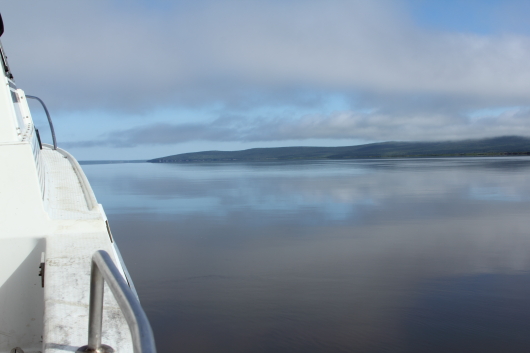
As we motored north toward the tundra, the morning clouds broke up to reveal clear blue skies reflected in the still waters of the Kolyma. © Becky Tachihara
The gun-metal-gray sky and river seemed to deepen the depressed state of Cherskii town. In Soviet times, this was an active river port. Rivers still link isolated Siberian settlements, not only along the length of a single river, but across the network of rivers, the Yenisei, Ob, and Lena, each larger than the Mississippi, all flowing northward into the marginal seas of the Arctic Ocean. The towns were jumping in Soviet times—coal, oil, military supplies, people moving up and downstream—but now they’re dead or dying, and Cherskii, I hear, is typical: Forlorn ten-storey apartment cubes that must have been depressing as hell when alive, but, now, empty with blackened, corpse-eye windows, they’re monuments to failure and despair; fallen-down structures that once were something, but, roofs caved in, they’re too far gone to tell what; fifty-gallon oil drums, some flattened, others still round, all rusting away on the beach; ghostly, heavy-lifting ship cranes standing along the seawall as if vainly waiting for ships to load.
Then we pass the Cherskii airport, a dusty, dirt strip with more crashed aircraft lying about than a nervous flier would like to see. We’ve also seen Cherskii in sparkling bright sun, but when the light shines on the field of silver oil-storage tanks at the top of the hill it reflects only dark irony, never possibility.
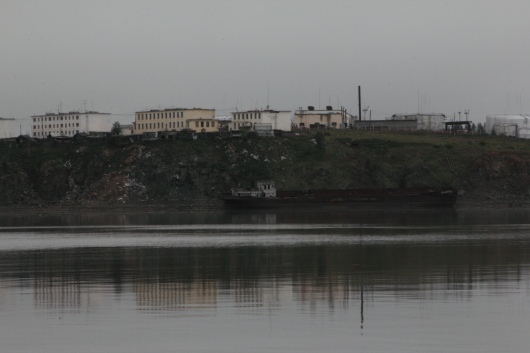
A settlement north of Cherisky stands forlorn on the banks of the Kolyma where an abandoned cargo barge lies abandoned at the base of the cliffs. © Becky Tachihara
Our little flotilla motored on down the dance-floor-flat and sprawling-wide Kolyma River. Often, after Sergey motioned for me to take the wheel, I couldn’t distinguish, without his hand signals, the main channel from broad bays and vast lowlands. There seemed always to be land ahead. I had envisioned something like the Hudson or the Ohio River. But those riverbeds are disciplined by topography or by human intervention. Not the Kolyma. It’s wild, untrammeled, and, flowing over flat land, it’s free to spread out and breathe with the seasons. A low-flying chevron of white, long-necked swans crossed our bows.
“Here we stop,” said Sergey two hours later.
Where?
“This is end of trees.” He slowed, the bow dug in, and he turned toward the right bank. From here north to the East Siberian Sea, there’s not a single tree.
We climbed the bouldered bank onto spongy ground, like walking on a mattress of mosses and unidentifiable lichens, Labrador tea, and bearberries spotted with wildflowers, purple fire and forget-me-nots and who knows what else. The tundra is beautiful in its sheer strangeness, an exotic environment, and vaguely haunting for that. Here summer seems not a season, but an exception.
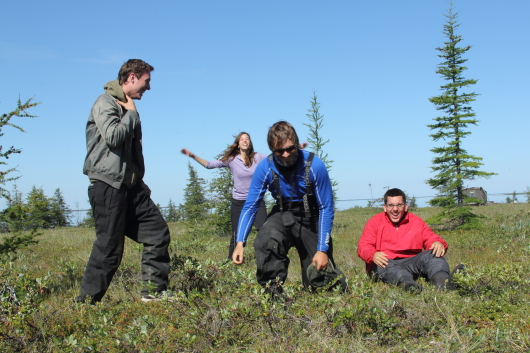
On our way to the tundra, we stopped at the northern tree boundary. While the terrestrial team worked, the rest of us picked berries! © Becky Tachihara
We shed layer after layer in the heat, down to tee shirts and a coating of Deet. People sprawled on the tundra and played like kids on the first fine summer day at a Coney Island 69 degrees North. Others, however, did some science. The terrestrial team picked a spot that seemed typical, laid down their meter-square pipe frame, then plucked and bagged every bit of vegetation within it. They’ll take the sample back to the lab, segregate it into varieties, and weigh it. Then they’ll dry it in a purpose-built oven and compare that weight to the moist weight. In the final step, they burn it down to ash and weigh the ash. The difference between that weight and the dry weight equals the quantity of carbon it contained.
Other students took tree-core samples, extracting soda-straw-sized cylinders. These they sand smooth, mount in a slot of wood, and under the microscope count the growth rings. This process, repeated on nearby trees to factor out anomalies, produces season-to-season climate information. Allison had showed me a microscope view of a larch tree about five inches in diameter that was 250 years old. Here at the stressed edge of their existence, 250-year-old trees were probably smaller still.
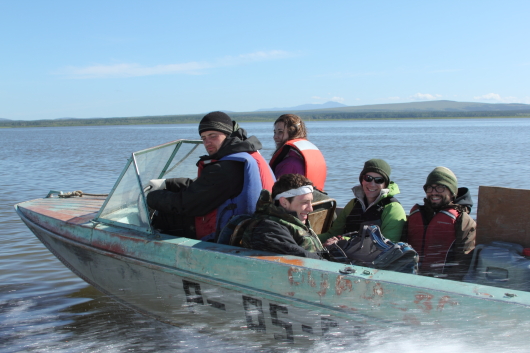
Nikita speeds past us in “The Forty.” His passengers are hunkered down for the long trip, but are also positively beaming with excitement. © Becky Tachihara
We reloaded the boats and headed farther downriver past the landmark shack where the veterans sheltered last year. We stopped on a slate beach strewn with the weathered trunks of huge trees and broken branches. It’s easy to visualize from the size and quantity of the driftwood the Kolyma’s terrible force of flow during the spring ice-out, called the freshet.
Picking our way through the knee-high dwarf birch, we climbed to the crest of a steep-sided hill for a panoramic view of the vast, green, beautiful floodplain through which the little Sukharnaya River wove sinuously, and there we stopped.
“Here,” Sergey said, “was town. During war, KGB took people off streets of Moscow, St. Petersburg, all cities, doctors, workers, any persons, and sent them to fish for food. Hundreds of tons of fish they took from here. Many persons died.”
“What was the name of the town?” I wondered.
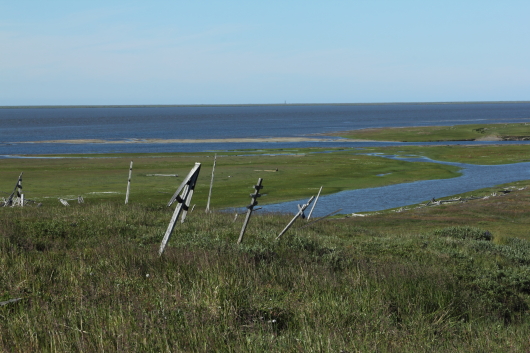
The remnants of a Soviet-era fishing settlement stand scattered on a ridge overlooking the tundra toward the mouth of the Kolyma. © Becky Tachihara
Sergey didn’t know. It was nameless now. There was nothing left but stray pieces of lumber lying patternlessly on the plain. You’d take them for driftwood; you’d never know humans lived and died in this sublime isolation—were it not for the dozen or so sad, weathered grave markers, crosses and broken Russian Orthodox religious symbols made of gray, weathered boards and mounted on tall driftwood poles, in order, I suppose, that they remain visible above eight feet of snow. Some were still standing straight, others canted at acute angles on the way to collapse; some had already fallen.
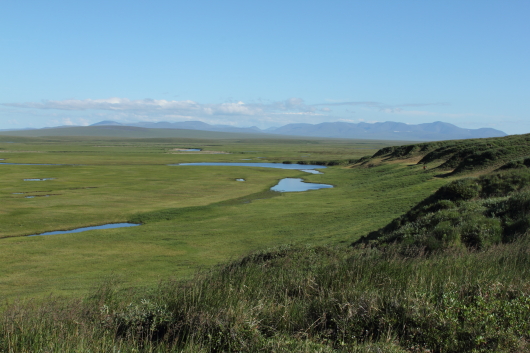
Hiking along the ridge near where we landed the boats, we had an amazing view over the tundra and across the Sukharnhaya River to the dark shadows of mountains in the distance. © Becky Tachihara
We turned our backs on the ghosts and, incongruous in our yellow, black, red, and orange high-tech wicking wear, made our way downslope toward the river. I figured we were off on a general sightseeing hike, but, no, there was purpose to it—the same for which the KGB snatched people off the streets—fish. You could see nice-sized grayling hanging languidly in the clear water, quite different from the tannin-dark Kolyma. Sergey and Max assembled spinning gear, and Eric his fly rod. They caught fish on their first casts. Eric turned out to be a skilled fly fisherman, but then he’s Norwegian. (That evening we’d learn about the Oslo bombings.) Matt caught a fish nearly a meter long with black spots and red slashes on its flanks that no one, not even Sergey, could identify. It was a sylvan scene right out of A River Runs Through It if you ignored the expanse of tundra and the purple mountains in the far distance. But then, as ever, it was time to go.
We trudged back to the beach.
“Is there anyone behind you?” Nikita, safety officer, asked.
“I don’t think so. There usually isn’t.”
Max and I, in the slower twenty, took off first. Sergey in Speedy didn’t catch up until we were in sight of the Cherskii, white light glinting on oil tanks. Where was Nikita and the five others in the forty?
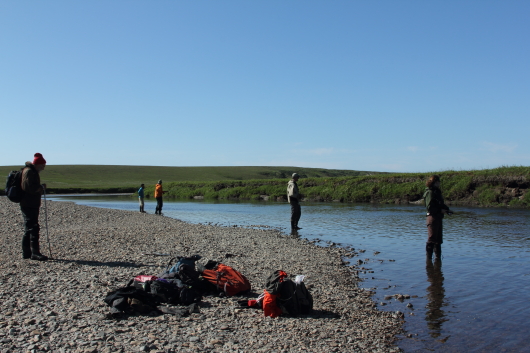
Matt, Eirik, Max and Ludda stand ankle deep in the Sukharnhaya River, casting their lines and waiting for fish to bite. © Becky Tachihara
We pulled alongside the barge only minutes after Speedy to find Jorien, Paul, and Sergey Davidoff unloading their gear from their trip back upriver to Duvanii Yar for more water samples. Then Nikita’s boat arrived. It was 2030, a half-hour before dinnertime.
“Amazing,” said John, who’d stayed behind. “We didn’t expect you back till about midnight. So what happened?”
“Nothing. It was easy and beautiful.”
“Then what are you going to write about?
“About how it was hell out there. Rain, snow, thirty knots across the deck. We were lucky to get out with our lives.
“Okay. Good.”
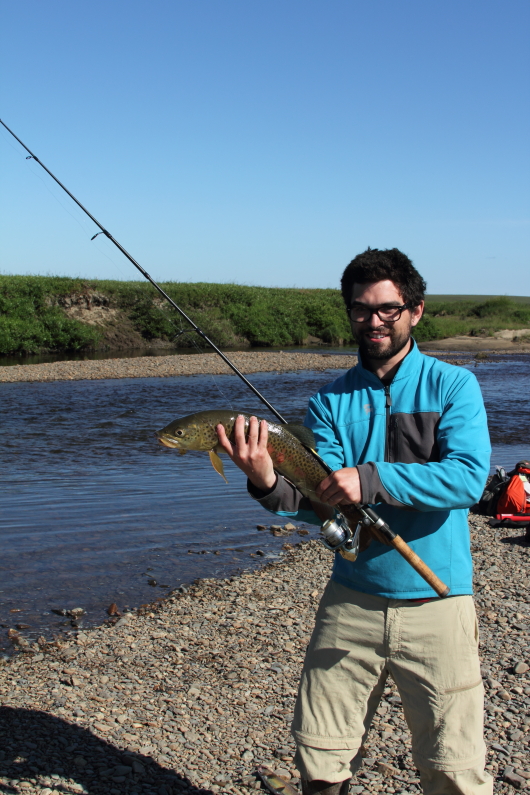
Matt shows off the biggest catch of the day. We’re still not entirely sure what kind of fish it was, but it sure was tasty. © Becky Tachihara




Comments(2)-
Peggy says
July 26, 2011 at 11:57 pmSomeone with a background fishing in Alaska says that fish looks like an Arctic Char. Good catch.